Graham Farish
This section was originally written in the late 1980s, since that time Farish has been taken over by Bachman and a number of new models have been introduced. This section lists the pre-Bachman models, the separate section on Bachman Farish lists all currently available models in the range. Where I believe older models have been withdrawn I will mark the entry as such, I understand that (as with several other manufacturers) the individual models are being produced in batches so some may reappear after a time. The text below remains the original text, updates will appear on the Bachman-Farish page.
With their provision for `Modern Image' stock Graham Farish have done a
lot to provide for the R-T-R modeller. My only reservation is their use of
non-blackened steel tired wheelsets with deep shiny flanges. One cannot
complain however in view of the support given by this manufacturer to the
scale. Personally I feel the wheels do not look as bad on the modern stock as
on the older wagons, but if it bothers you there are replacement (spoked)
wheelsets available from Mike Bryant on correct length axles, and the range of
spoked, three hole and disc wheels from Parkside Dundas can also be used (see
Kits & Continentals section for further information on these).
Unfortunately Graham Farish only sell the goods and coach bogies separately,
however wagons can be obtained second hand relatively cheaply for conversion
work. Do note however that this manufacturer has experimented with various
designs of coupler and some of the older type were not as successful as the
current spring loaded `Arnold' type.
Their original range consisted entirely of pre-nationalisation
prototypes, all being drawn from the Roche series of drawings. These are all
available in the pre 1937 large lettered livery, with the exception of the
steel open in LMS livery. They have now released selected models in BR
liveries, to date these are the 7 plank open and the single vent van in early
pre TOPS livery with the steel open and the Presflo hopper in TOPS livery. More
recently Graham Farish have collaborated with Taylor Plastic Models to produce
a BR standard 20' 9" air-braked chassis which entered service in the 1970's.
Graham Farish offer a range of ready to run models on this chassis whilst Mr
Taylor uses it as the basis for a range of modern image kits.
Chassis details
Graham Farish chassis are not available separately, they have the LNER
type axle box as standard.
Wagon chassis: Representing the RCH standard type it is a steel
underframed 10 foot wheel base, 17 foot 6 inches over headstocks design the
model is 36 mm OH, 20 mm WB and 49 mm OA. The Graham Farish brake van chassis
is 50 mm OH 33.5 mm WB and 62 mm OA
4 Wheel coach chassis: This useful item has been withdrawn to allow
production of models for another firm, I understand there are no plans at
present to resume production of the coaches, but the chassis may re-appear with
a new body at some point. This chassis is fitted with running boards along the
full length in the manner of a brake van. It is 63 mm OH, 40 mm WB and 74 mm
OA.
Modern AB chassis: This is the chassis supplied with Bernard Taylor's
kits, and was produced as a collaborative venture between the two firms, who
will not duplicate the bodies in each others ranges. It is 78.7 mm OH, 43 mm WB
and 92 mm OA.
Bogie open/bogie van chassis: This is the heavily trussed chassis for
the 50 ton open wagon.
Goods bogies (available separately): Diamond pattern, introduced about
1900 and used by all the Big Four, PO's and BR. The GWR generally preferred
`plate frame' types which can be produced by removing the bottom bar on the
Graham Farish type and fitting plasticard side plates stuck on with epoxy glue.
Passenger bogies (available separately): To date no definite data
available on the prototype used for the 'British' pre-BR bogies but I believe
they are based on an LMS design.
3 PLANK OPEN This is no longer in the Graham Farish range, but
may be found second hand. Do note that these will have the old style Farish
half-height coupling, which was not a great success (re-mounting the body on a
Peco chassis is the best option).
5 PLANK OPEN - - An SR standard `high goods' design, introduced
under Bullied some time after he became CME in 1937. Hence this wagon should
not have the large SR logo but the smaller standard format introduced in 1937.
I believe the end bracing should be steel L section rather than wood as
supplied but I might be wrong on that point.
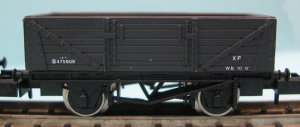
7 PLANK OPEN - Based on a pre-grouping North Staffs Railway loco
coal wagon, absorbed by the LMS in 1923 these vehicles continued in use for
Loco coal but it is also suitable for use as a Private Owner type. Note the
large lettering was replaced in 1935, just prior to the introduction of Bauxite
body colour, so this model requires re-lettering. A nice touch would be to give
the wagon a wash of thinned bauxite, so the large lettering is just visible,
then add new lettering to give the impression of a heavily weathered,
re-painted, wagon.
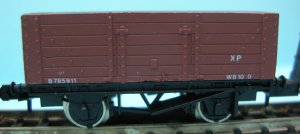
STEEL OPEN - This particular wagon is a Butterly design dating
from the mid 1930's, further examples were built in 1946. These wagons were
built for the LMS and possibly some private owners, the small lettered LMS
livery is correct. Quite a number of these wagons survived into the 1960s, I
believe the last of the type in revenue earning service were scrapped in the
late 1970s but a few may have survived in departmental use into the late 1980s.
I was content with this model until the Peco 16 tonner kit appeared, against which the body of the Farish wagon appeared over sized, I therefore modified my stock, reducing the height by cutting off the top rail (this was then glued back on) and replacing the ends to reduce the length to suit the Peco 9 foot wheelbase chassis. The photo shows the modified and unmodified models.

SAND/LIME WAGON - A seven ton Great Eastern Railway loco sand
wagon which was absorbed into the LNER at the grouping and may have lasted into
the early BR period. The model is perfectly acceptable as a Private Owner
wagon, designs for these being somewhat varied to say the least. Unlike the
Peco peak-roofed wagons the roof is not a removable addition to a standard
wagon body, the ends are integral with the body and the roof is secured to a
high false floor in the wagon by a pin. If you remove the roof and cut the ends
down level you get a 'four plank open' wagon, this doesn't resemble any
particular prototype I know of but adds some variety to a rake of wagons. The
sides need to be thinned a bit and the wagon has to be modelled 'loaded' due
the the high false floor.
The roof can be re-used, the model below is based on a Scottish bulk grain hopper used at Leith docks but lettered for a small 'light railway' layout.

PRESFLO 20 TON HOPPER -Introduced by BR in 1954, originally for
cement traffic they were also used for other bulk powders, such as salt, slate
powder, and alumina. This wagon was also used by BR from about 1966 to carry
fly ash traffic from power stations and these fly ash wagons were changed to
air brakes. The name Presflo refers to the 'air fluidisation' system built into
these wagons. The system works by blowing in air to `fluidise' the powder which
flows out of the discharge pipe in the air-stream. They were designed to be
emptied using a small portable air compressor and so might be seen in even a
small station goods yard where they would be discharged into lorries for
delivery. When new they were often seen in colourful PO liveries, although many
were in standard BR bauxite, lettering details will be found in the section on
post-nationalisation wagon development.
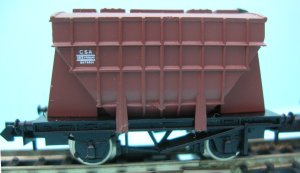
The fly ash trains were a block working in BR bauxite livery, now
available from Graham Farish (they were clean as they were washed down at the
power station after filling with the ash). The last two BR owned cement
carrying examples were condemned in 1987/88, but Blue Circle still owned well
over one hundred of these wagons at that time. The company logo was removed
from the private owner stock in 1985 and after that they ran in a livery of
plain pale grey with either white or black lettering. The BR fly ash wagons
were reported out of use and in storage in the mid 1990's. (See also Lima
Prestwin)
OPEN HOPPER No longer in production (the top can be removed from the presflo model) - This is simply the lower body from the Presflo
wagon and is not as far as I am aware based on a real prototype. With a bit of
carving however it forms a good basis for an iron ore hopper and in the absence
of anything else it was a welcome addition to the available N Gauge rolling
stock. The models shown have been modified to represent end-lever and side-lever braked LNER hoppers.

TWIN VENT VAN - - An SR design, the alternate wide and narrow
planks show it to be a 1939 version built at Ashford, earlier types,
originating in 1918 on the SECR, had even width planking. One flaw is the roof
profile which should have a more pronounced `droop' to the edge, giving a
characteristic almost semicircular end profile. This can be produced by sanding
the top edge of the sides and ends, although a replacement roof of 5 thou card
is required (Ralph Snelling has produced a replacement roof section which is
available to members of the N Gauge Society). These wagons were supplied to
other railway companies during 1940's, however the only liveries supplied are
pre 1937 and are incorrect as they pre-date the design. The model shown is in the process of being re-painted but retains the original Farish roof.

The N Gauge Society has now produced a useful multi-kit of the type which has the correct roof profile
SINGLE VENT VAN - Based on an LNER vent van dating from about
1934. The LMS had a similar van, introduced in about 1931, however the LMS
livery supplied by Graham Farish is for a different type of van. The pressed
steel ends on this wagon are useful for making models of some BR stock. The model shown has been (rather crudely) repainted in BR 'unfitted' livery.
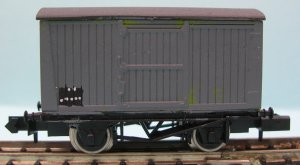
FISH VAN - A Great Northern Railway `fitted' fish van design
which passed to the LNER at grouping. Incidentally the LNER moved the greater
part of the home waters catch of fish, hence rakes of such wagons would be
appropriate. As a fitted wagon these might have been seen attached to passenger
trains up to the Second World War.
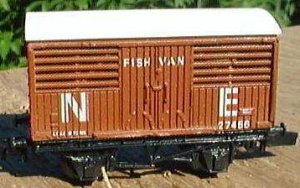
CATTLE WAGON - A Midland Railway standard design perpetuated by
the LMS. To add a little interest to the roof one can add strips of plasticard
or postcard to form the thin wooden strips used to prevent the nails holding
the canvas roof sheet from penetrating and possibly injuring the cattle. Note
the ends are standard MR van ends and so substitute sides can be used to
produce a selection of MR/LMS vans. The only flaw on the model is that the white end inserts of the roof are rather visible through the upper sides, but a lick of paint solved that. The model shown still has the old style Farish shiny wheel sets.

One sometimes sees pictures of cattle wagons with white interiors and white stains on their sides caused by `lime washing' the insides of the wagons as a way of disinfecting them. The interior of these wagons should be all white and the liquid leaked out between the planks as well as through the built-in openings. There would be patches of white all over the body but mainly where there were gaps such as the openings at the bottom and around the open upper sides. This practice was banned in the 1920's, so the stains should not appear on Big Four or British Railways stock. The photo shows an example repainted as an MR van.
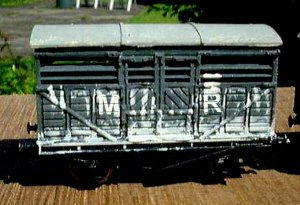
HORSEBOX - - This is a standard Great Northern Railway horse box.
The Cheshire Lines Committee obtained their horse boxes from the GN (who were
part owners of the CLC) and I think this one passed to the LNER eventually.
Possibly also used by the LMS as stock from the CLC was spilt at the time of
the grouping between the two companies who jointly operated the line. Generally
horse boxes ran in non-passenger coaching stock livery, the model is available
in PO livery at present, the essentially similar LNER livery has been included
in the Livery section drawings. According to the Roche drawing six torpedo
ventilators should be added to the roof, these are available from the Ultima
range for details of which see the following section on kits. The basic body can be cut down to represent a typical small type seen on pre-grouping lines, although this does require the shortening of the chassis (in my case I used a cut-down Peco chassis kit).
Fig___ Grafar Horse box in LNER livery and 'Light Railway' version

OIL/TAR TANK - This rectangular tank is of a common older design,
introduced in the late 1880's, very few of this type were built after the mid
1920's. Tanks of this type were mainly used by private owners, particularly gas
works for coal tar but also chemical companies as well as by firms carrying
petroleum oils. They were generally replaced by cylindrical tank wagons for
lighter spirits but remained in use for heavier oils and tar into the 1960s.
Similar wagons were seen in service (carrying Shell-BP fuel oil) in 1961 and
they have been used by BR for fuel oil at outlying diesel depots into the
1970's at least.
BOGIE OPEN - This represents the 50 ton bogie ammonium sulphate
wagons, about a hundred of which were built by the LNER to carry sacks of the sulphate, in which traffic they were sheeted. These
were amongst the largest open wagons built for British rails up until the late
1960's. The BR livery is correct but Graham Farish used to offer this wagon in
LNER red oxide livery which is incorrect, these were `unfitted' wagons and so
should have a grey body (the Roche drawing on which the model is based is
incorrect). The photo shows the original Graham Farish model, that has been fitted with Mike Bryant wheels.
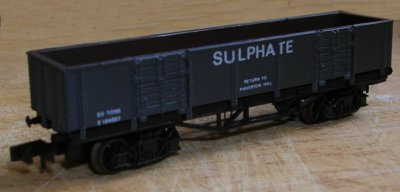
These wagons were subsequently used for a weekly train moving rubbish out of London in the later 1960s and early 1970s (when they were replaced by redundant 16 ton mineral wagons). Both types were unsheeted when in this traffic and I gather the smell was a bit strong. The London terminal was located where the current Arsenal football ground is today. Kevin Allsop on the newsgroup uk.railway was able to advise The depot was Ashburton Grove. There was an 08 outstationed there, manned by Kings Cross drivers, at least until 1980. A new Waste Transfer Depot was built there in the late 1980s, with waste removed by road. As part of the Arsenal stadium redevelopment a replacement depot at
Holloway had to be provided. This is supposed to have provision for a possible future return of the traffic to rail.
On the same thread Peter Lawrence advised that- The destination was Blackbridge tip, near Wheathampstead, now full up
but easily recognisable by walkers along the footpath on the branch
line formation. The Black Bridge itself has been removed though.
Incidentally, Wheathampstead station yard had a dung siding once used
for wagons of the stuff supplied by London Zoo to local farmers.
Apparently this also was sent via Ashburton Grove but I don't know how
it got there from the zoo!
The same wagon is offered as a GWR loco coal wagon, which is not
convincing, the original wagon had five metal doors per side and curved corners
and ends giving an almost tub shape to the body. The same wagon was once
available liveried as a 50 ton bogie brick wagon used between Fletton and
London. These wagons were in fact wooden sided, the GNR originals had six plank
high sides, the LNER built essentially similar wagons with sides five planks
high.
Fig ___ Large Bogie Open Wagons

BOGIE VAN Not currently in production - A North Eastern Railway van, passed into the LNER in
1923. Some seen until the 1970's possibly the 1980's in departmental service on
BR. The underframe with its heavy trussing is that used for the 50 ton bogie
sulphate wagon but this van had little in the way of under trussing. Removal of
the brake handles and cutting away the heavy bars whilst leaving the outer two verticals and running thread across these produces a reasonable effect. Note the doors and roof hatches which may be used as a
guide for modifying the Peco Reefer van to an NER 10t van. The photo shows the original Graham Farish model fitted with Mike Bryant wheels.
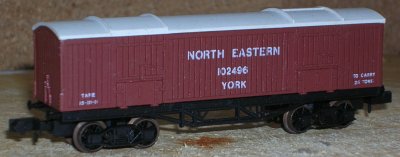
The Lancashire and Yorkshire Railway and GWR also operated large bogie vans, the GWR type can be made from a couple of 'iron mink' kits with a new roof. The L&Y type can be built using Peco insulated van ends with new sides and roof or it can be modified from the Farish van by replacing the sides, adding the distinctive inverted V end braking and changing the roof doors to the L&Y cloth-and-bars type. For both a home-made chassis of 30 thou card sandwiched between two strips of 10 thou card with trussing from wire is preferable to using the Farish chassis.
100t TANKER - These high-speed high-capacity wagons first
appeared on the railways in 1966, some two years prior to the blue corporate
livery. The PO liveries were phased out in about 1974 as being too expensive to
maintain. By the mid 1980s the tanks were now usually grey with red sub-chassis above the bogies for class A liquids (eg petrol) or
black for class B liquids (eg fuel oil) and were not cleaned very often.
The 90 ton LPG tank version can be modelled by removing the end ladders and top walkways, leaving a slot along the top of the tank. The slot can be covered with a strip of 10 thou card extending down almost to the centreline to represent a 'sun shield' and the filling hatches can be represented with 10x10 thou strip and scraps of 10 thou card.
These wagons can run alongside the Peco
fifteen foot wheelbase LPG wagons.
Interestingly tank wagons to a basically similar general design were
built in the 1950's or possibly even the late 1940's, although the tanks used
were only about half the capacity of the 100 tonners. The diameter of the
Graham Farish tank is a shade on the large side but if you remove the ladders
and catwalks and shorten the wagon by cutting a section from the centre you get
something not unlike one of these earlier wagons. You would have to fill in the
slot along the top and add new ladders and filling domes and apply your own
livery. There is an illustration in Don Rowlands book on early BR Freight
Wagons which shows one of these early tanks, with a 40 ton payload, used by a
specialist haulier for liquid latex traffic out of Liverpool docks.
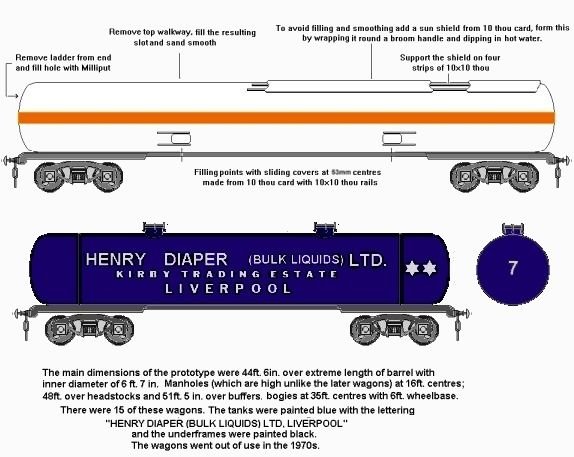
CONTAINER FLAT - A standard BR Freightliner wagon, introduced in
1964. The bogies are a little on the heavy side for this wagon, being (I am
informed) better suited to the bogie tanker, for which they were originally
produced. The `Freightliner' liveries offered are the two most recent of four,
but I am unsure of the exact periods they cover. Alternative transfers are
available from specialist suppliers, and Graham Farish produce unpainted
`boxes'. One possible mod to this model is to fit a wooden (scribed card) floor
with raised ends and drop-flaps to cover the buffers. Modified container flats
of this type are used for carrying commercial vehicles (up to at least 1987).
See also the Lima Freightliner wagon entry.
Brakevans
GWR - A standard GWR `Toad', introduced in about 1912. Should be
a 16 foot wheel base but looks well enough, the difference is not really
noticeable. BR also built further examples of this design but they were
generally confined to the Western Region area, and were in fact marked ``NOT IN
COMMON USE''. The BR liveried version is of an unfitted type
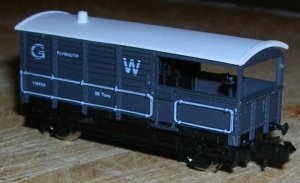
SR/LMS - - The SR version serves quite well an ex LBSCR design,
which saw service up to the early BR period. The LMS version requires some
modification, principally the fitting of `duckets' over the side windows
(similar to those on the Peco brake van) to represent an early 1930's design.
Modern air braked chassis models
This chassis was produced by Graham Farish in association with Bernard
Taylor of Taylor Plastic Models. It has only one drawback in that it appears to
be made from a material resistant to the normal range of plastic solvents,
'Superglue' however works rather well. Similar chassis were used as early as
1960 when six experimental low sided wagons were built to test the air brake
system, other experimental vehicles included vans with different door designs
and tarpaulin 'curtain' sides. Graham Farish offer two liveries, the post 1964
British Rail bauxite with double-arrow and the later post 1980 'Railfreight'
red and white.
OAB/OAA open wagon. Introduced in 1971 this was the first of the
standard wagons on the new air-braked 20 foot 9 inch wheel base chassis and has
steel ends with wooden drop sides. OAB is not a TOPS code but an abbreviation
for Open AB, the original code for these air braked vehicles. OAA is the TOPS
code for the wagon. Available in both liveries. It is worth noting that these
were supplied with a plastic tarpaulin, usually pale olive green in colour,
marked in white letters about 6 inches high: TO BE RETAINED WITH AB OPEN
WAGONS. These wagons are still in service, some are used for palletised roof
tile traffic and carry the Redland livery.
VAB/VBA sliding door van - The model is produced in the same two
liveries (post 1964 bauxite and post 1980 Railfreight) as the open wagon
described above. VAB is an abbreviation of the original Van AB code but I
believe the code should be Cov AB as I understand Van AB was used as the code
for some of the Vanwide ten foot wheelbase vans which had been fitted with air
brakes. I am not absolutely certain of the pre-tops codes but VBA is the
correct TOPS code for the vehicle (it has no end ventilator, adding one produces either a VAB fitted with a pipe to run with vacuum braked stock or VAA un-piped van).
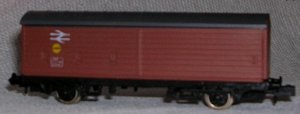
FPA (Conflat P) container flat - Used mainly for open topped
(minerals and coal) containers this wagon is to be supplied by Graham Farish
with a standard ISO container load. Taylor Plastic Models sell the wagon with
the option of one of two different types of open (coal) container.
PCA (cylindrical tank) This represents one of the modern
air-fluidised power carrying vehicles, built for operation by private owners
and wagon leasing firms, introduced in the mid 1960s. They are used for cement,
grain and various powdery chemicals. Blue circle (and several other cement
companies) discontinued their colourful liveries in the mid 1980s and most of
these wagons have run since in a plain livery of light grey tank on a black
chassis, usually with simple TOPS lettering in white. The company liveries have
made occasional reappearances however and I understand that the liveries on
offer are all appropriate.
PCA (depressed centre tank) This represents a PO design gravity
discharge power carrying wagon which appeared in the mid to late 1960s and
became the most popular design for cement traffic. The comments on livery for
the cylindrical PCA tank wagon above also apply to this design. In the early
and mid 1990's these wagons were seen passing through my local station several
times a week (carrying chemical powders) and featured a livery of a plain if
rather dirty white or possibly light grey tank on a black chassis as discussed
for the cement wagon above. In the 1970's a bogie version carrying a pair of
depressed centre tanks (similar to those on the Graham Farish wagon) and
equipped for either gravity or air fluidised discharge were built (these
remained in service at least into the early 1990s). Subsequent builds of the
single tank four wheelers also had the air system built in as an option. The
bogie types are also used for china clay traffic in a rather fetching bare
metal 'silver' tank livery.
PGA Open Hopper These are the successful 50-ton GLW PO hopper
wagons designed and built by Procor for road-stone traffic in the mid 1970's.
With the cutback in road stone useage the wagons have been pressed into service
on a number of duties (in 1998 rakes of these wagons have replaced the old ICI
vacuum braked 23 ton bogie hoppers on the Northwich-Tunstead limestone run, problems with dust blowing off and high vibration from the non-welded rail saw them replaced by large bogie types a couple of years later).
PGA Closed Hopper
This is the roofed version of the Procor 50-ton hopper wagon, some are
used by 'stone' firms and the model serves well enough for sand or salt wagons,
the vehicles used for these commodities are broadly similar in design but with
differences in the external ribbing and the design of the roof. Bernard Taylor
of Taylor Plastic Models has released a detailing kit for use with the British
Industrial Sand wagon. The sand wagons are used for chemically treated and
purified sand used in glass and ceramic making. Broadly similar hoppers are
also used for a number of granular or powdery chemicals.
____________________________________________
^
Go to top of page

















